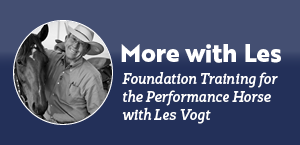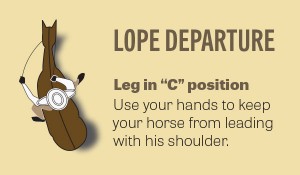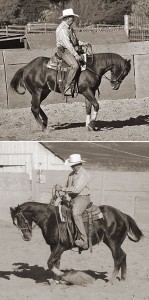 Setting the horse up correctly for crisp, clean lope departures is a critical component for any reining pattern and a necessary prerequisite for lead changes. You should be able to get your horse in position, that is, be able to push his hip toward his eye, so that you will be able to ask him to lope off on the correct lead, although you might be getting a few trotting steps in the meantime.
Setting the horse up correctly for crisp, clean lope departures is a critical component for any reining pattern and a necessary prerequisite for lead changes. You should be able to get your horse in position, that is, be able to push his hip toward his eye, so that you will be able to ask him to lope off on the correct lead, although you might be getting a few trotting steps in the meantime.
At some point, you’re going to want to put him in position with your hands, cue him with your leg and NOT let him go anywhere until you feel him reach up and commit to the lope with his hind leg. Once he does, turn him loose and let him go. It’s something you work up to slowly, but there will be a point where it’s time to raise the bar and insist that he lope off from a walk, and eventually from a standstill. All it takes is patience and practice.
 Here’s the sequence for a great lope departure. First you want to ask the horse to flex at the poll while you send him forward at a walk. Then, without losing momentum, push your horse’s hip a step toward the lead you want to pick up, while keeping his shoulders straight up with your reins. This is sometimes called scoring. Finally, bring your outside leg into firmer contact and cluck as the signal for the lope departure. Keep in mind that it’s actually the same positioning you’ll use to change leads later on, so it’s critical that you lay the foundation correctly here.
Here’s the sequence for a great lope departure. First you want to ask the horse to flex at the poll while you send him forward at a walk. Then, without losing momentum, push your horse’s hip a step toward the lead you want to pick up, while keeping his shoulders straight up with your reins. This is sometimes called scoring. Finally, bring your outside leg into firmer contact and cluck as the signal for the lope departure. Keep in mind that it’s actually the same positioning you’ll use to change leads later on, so it’s critical that you lay the foundation correctly here.
What people have a tendency to do is to let the horse go too early when they ask for the departure. Keep hold of the horse and keep your weight back. Don’t lean forward and don’t ride up over the horse. Keep after him with your leg until you feel him commit to the lope by reaching forward with his inside hind leg in response to your cue. It could take a while before you get good departures, but it will happen.

Getting ready for a lope departure: I am using a brace rein to keep the shoulders in place while I push the hip into the lead with my leg. Don’t through your reins away until you feel your horse commit to the lope with his hind leg.
Many horses will want to raise their heads and really elevate their front end when you ask for the lope. To correct this you’ll want to make sure that your horse is really soft in the face and that you’re using a lot of impulsion. If he’s reaching into the lope with his back leg first, he should be able to stay rounded as he departs. If he starts to get strong on you, or tries to lift and throw his front end into the lope first, go back to the basic collection work for a few minutes, working on pushing him up to the bridle, and then try again. You need to insist on the correct position right from the start.
When you think about the body position, the lope departure is a lot like the stop. The horse should be relaxed in front and reaching forward with his back legs—front motor slow, back motor fast. So if you have problems with your departure, you’ll have similar problems when you start stopping in earnest. Things will go easier then if you solve your problems now!
When you practice your departures, make sure that you’re not always doing them next to a fence, or worse in the same place every time. You want your horse to rely on you for his cues, and the fence might be hiding a problem that won’t show itself until you’re out in the middle of the arena. Don’t worry about the departure being perfect at this point as long as the neck is. As your collection and hip control improve, so will your departures.
Continue working on your walk-to-lope departures until you can get them consistently on both leads.
Leave a Comment
All fields must be filled in to leave a message.